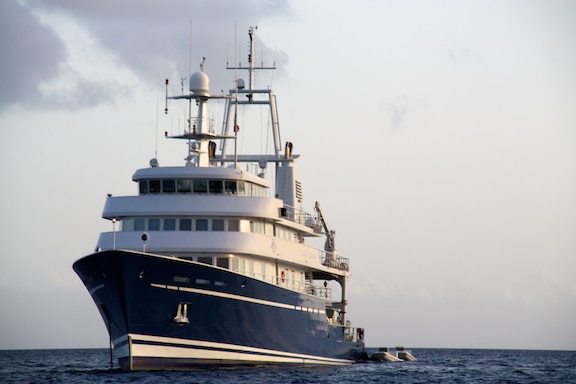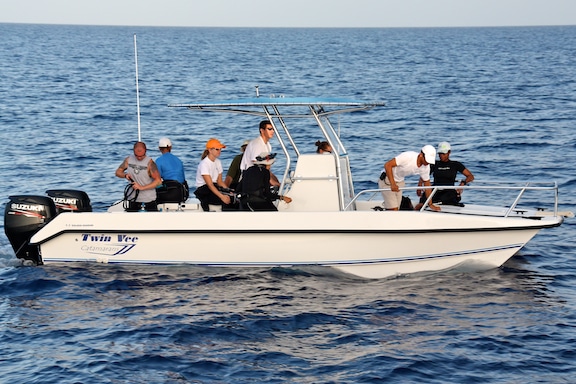Sunshine and calm seas greeted the Golden Shadow as she lay at anchor in Man of War Bay on the west side of Great Inagua. After a quick breakfast, the first researchers set off to start the day’s survey work.
Coral Reef Research Teams
The scientists on board for the Inaguas leg of the Global Reef Expedition have been organized into several coral reef research teams. Team Parrotfish is engaged in reef fish herbivory studies, while Team Barracuda members are responsible for recording the benthic organisms including coral coverage. Team Eagle Ray is surveying fish, corals and any coral diseases they encounter during their underwater investigations.

Team Worldview is responsible for creating underwater maps of the area. They accomplish this in part by groundtruthing data that has been previously acquired from satellites and aerial photographs. The team validates existing satellite map data by collecting depth soundings, taking videos of the seafloor, and making observations that will assist in the process of generating detailed habitat maps for the area. Additionally, the team uses a technique called sub-bottom profiling, which utilizes highly specialized equipment to send out acoustic energy that penetrates beneath the sea floor. The sound waves help the scientists identify and map the composition of sub-surface materials, such as sand and limestone rock. The picture generated by this method of sampling reveals the arrangement of sub-surface materials and helps coral reef researchers understand more about the composition and structure of the reef. For example, in the Bahamas deep, eroded formations known as blue holes will often occur in the limestone bedrock. Sub-bottom profiling allows researchers to tell the difference between how deep a blue hole really is, and how much of it has been filled in by sand. In this way, the acoustic surveys help to tell the story of the reef’s geological history. This helps coral reef researchers to understand the bigger picture of reef formation and gradual changes over time.


Finally, Team Hollywood, which is composed of two cinematographers, is roving between all the teams to document the research that is taking place on this expedition. The footage will be edited into a broadcast that will tell the story of the Khaled bin Sultan Living Oceans Foundation and the Global Reef Expeditions to a larger audience.
This morning, the first groups of scientific divers (Team Worldview and Team Barracuda) departed for the dive sites and began surveying. Immediately after lunch and a quick swap out, the second teams (Team Eagle Ray and Team Parrotfish) left to dive. Each coral reef research team is able to do two dives per day. This will increase to three dives a day once our large dive boat, the Golden Osprey, joins us. The Osprey has been forced to wait out Tropical Storm Emily and the storm’s remnants before they can safely head south to join the Golden Shadow in the Inaguas. Until the Osprey arrives, the coral reef research teams must share the small Twin Vee catamaran that can carry eight people to a dive site. The arrangement seems to be working well so far, and today proved to be another productive day for both data collection and teamwork.

Written by Kit van Wagner
(Photo/Images by: 1 & 4 Kit van Wagner, 2 – 3 Dr. Sam Purkis)
To follow along and see more photos, please visit us on Facebook! You can also follow the expedition on our Global Reef Expedition page, where there is more information about our research and our team members.